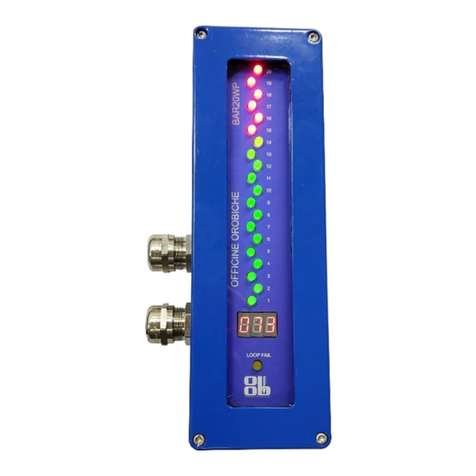
OFFICINE OROBICHE S.r.l. 4/4
24010
Ponteranica
(Bergamo)
I
TA
LY
-
via
Sere
na,
10
-
Tel.
+39
035
453021
1
-
Fax
+39
035
570546 - www.officineorobiche.it - e-mail: [email protected] ******************************************************************************************************************************************************************
LUG.20 Information subject to changes without prior notice IST/160-I
9. RECOMMENDED SPARE PARTS
The recommended spare parts are:
-Glass components
-Seals
In ordering spare parts, please always mention the unit’s serial number.
This number can be found on the rating plate of the instrument, which can be found on the housing, and is a number
composed of five digits which are preceded by the letter ”F”(e.g.:F45678).
10. TROUBLESHOOTING
Visual flow indicators are not normally subject to operating failures; in the event of an operating failures, please refer to
paragraph 7 MAINTENANCE, or contact our Customer Service department.
11. DISPOSAL
When the instruments have come to the end of their service life, they need to undergo disposal.
Always comply with the applicable regulations in force.
During the disposal stages, specially mind the polymers, resins and rubbers used in the manufacture (such as PVC, PTFE,
PP, PVDF, neoprene, viton, etc.).
All metal parts, after the removal of seals and gaskets, special protective coatings requested by the customer and all other
plastic parts, can be recycled.
12. GUARANTEE
All visual flow indicators are guaranteed to be free from manufacturing faults over a period of 12 months from the date of
shipment.
In the event of failures, implying return of goods within the limit specified above, OFFICINE OROBICHE will replace
(shipment fees not included) all damaged parts free, provided that the failure does not ensue from incorrect use.
OFFICINE OROBICHE shall never be held responsible for any incorrect use of their products when these are used for
purposes other than those mentioned in the specifications approved at the order stage.
In these cases, no complaints will ever be taken into consideration.
No damage and/or fee, whether direct or indirect, ensuing from an incorrect installation or use shall ever be debited to
OFFICINE OROBICHE.
The instrument can be used for a maximum life period of 10 years dating from delivery.
When this period is over, there are two alternative options:
1) Replace it with a new instrument.
2) Have the old instrument overhauled by OFFICINE OROBICHE.
INSTRUMENT RETURN PROCEDURE
The instrument returning to the factory shall bear, in attachment, the following data:
1) Buyer’s name.
2) Description of the material.
3) Detected fault.
4) Process data.
5) Specification of the fluids that have been used with the instrument.
The instrument shall be returned perfectly clean and free from dust or deposits. Otherwise, OFFICINE OROBICHE
reserves the right not to carry out the servicing and return the instrument to the sender.
FINAL REMARKS
Each instrument is supplied fully assembled and equipped with all the needed accessories.
Some parts are sold separately under special circumstances only.
Therefore, we warn you to carefully inspect the supply and notify us at once if discrepancies are found.
N.B. IN CASES WHEN THE INSTRUMENTS ARE MEANT TO BE USED IN AREAS FEATURING POTENTIALLY
EXPLOSIVE ATHMOSPHERES, THE USER SHALL COMPLY WITH THE ADDITIONAL SAFETY
INSTRUCTIONS ATTACHED TO THE STANDARD ONES.
























